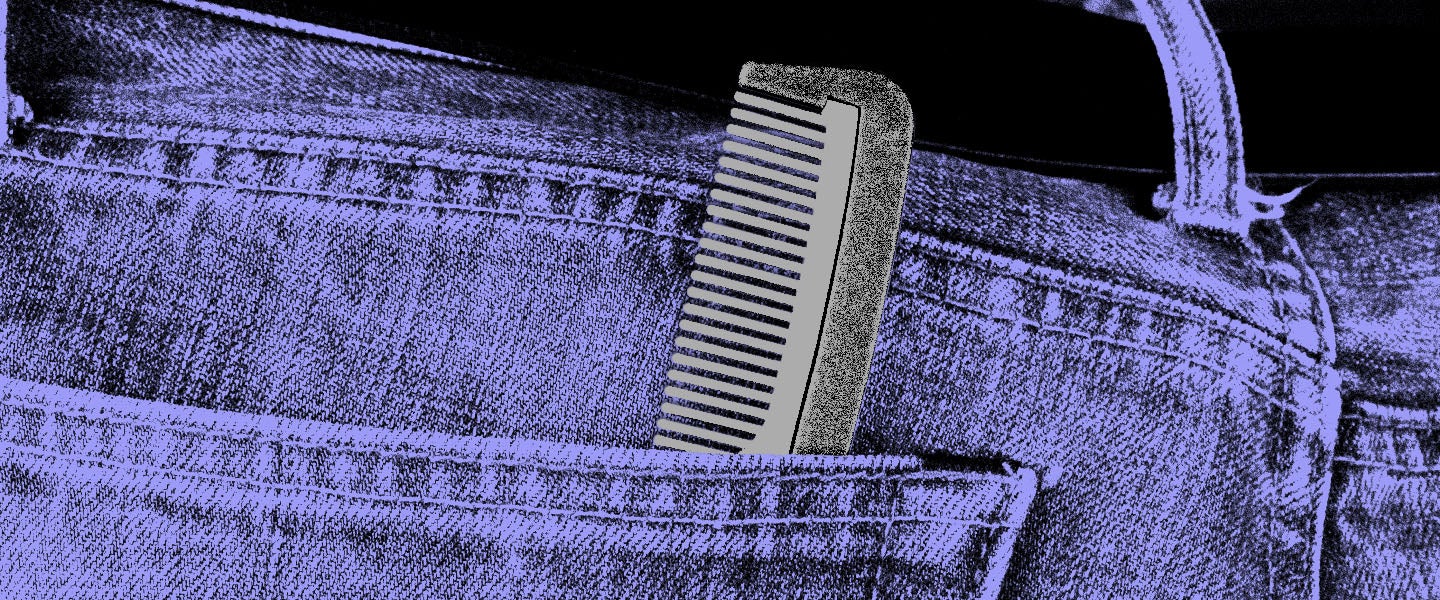For the past week, I’ve kept a comb in my front left pocket, and I’m here to report that it will remain there long after this article disappears into the black void of online content.
The poetry of the pocket comb begins with the way it neatly fits into my slim jeans as though it’s a part of my upper thigh that I’ve been missing for all these years and have just now reclaimed as my own flesh. Its color: Tortoise shell. It’s burden: Weightless. The pocket comb is me, and I am it. Our relationship is like the flowering plant and the insect — I give it purpose and it gives my coiffed hair the perfect tousled pick-me-up on a slouching Tuesday afternoon, once the weight of corporate responsibility has rendered my mane toothless and dull.
My only question is this: Why aren’t we all still carrying a comb around?
The big boom in pocket combs first happened for ladies in the 1920s, says Jessica Glasscock, a fashion historian at the Parsons School of Design. “It was promoted especially by the manufacturer of rubber products (like Vulcanized Rubber Co.) and sold in drugstores,” she tells me. The comb is an ancient tool, of course, first showing up at least 5,000 years ago and made from pieces of wood or ivory, but it wasn’t until Charles Goodyear’s “discovery of the vulcanization process, which cured and toughened rubber in ways that made it a more useful material,” that the comb began to take its modern-day form,” reports Atlas Obscura.
Now, you’ll probably notice that if you own a comb these days, it’s not made of rubber. That’s because the modern comb is a product of John Wesley Hyatt’s development of celluloid, a transparent plastic. “Hyatt was inspired by an 1863 contest that offered a $10,000 prize for anyone who could come up with a billiard ball that wasn’t made of ivory,” reports the same article in Atlas Obscura. “Hyatt never came up with the billiard ball, but he soon was producing combs.”
Although initially marketed as a women’s accessory, ultimately it would be the men donning leather biker jackets and drainpipe trousers that would become the definitive association for the pocket comb. “Sometime around 1950 a motorcycle club in a small town in California gripped filmmaker Stanley Kramer’s imagination,” reports Retro Waste. “It inspired him to make a film in 1953 called The Wild One, which starred Marlon Brando and Lee Marvin as two crazy bikers who terrorize a small town.” Their look — leather biker jacket and form-fitting jeans — was further bolstered by James Dean and his coiffed hair, an image that came to define the aesthetic of the rebellious teenage greaser. And it’s a look that’s remained iconic — think Henry Winkler’s Fonzie in Happy Days or John Travolta’s Danny Zuko in Grease.
So what does any of this have to do with a pocket comb? It may seem foreign to men nowadays — especially considering so much of the standard male aesthetic is based on appearing to try as little as possible — but the upkeep of the greaser hairstyle (itself a direct response to the high and tight military cuts that dominated men’s culture in the previous decade) required constant tampering, hence the use of the pocket comb. “It’s recommended you carry a comb and a little pomade with you once you leave the house,” reports Lifehacker in their article on maintaining such an involved look. “Your cool new ‘doo will likely need some fixing throughout the day since the pomade keeps your hair wet.”
So why did pocket combs disappear as a cultural mainstay for guys? Blame it on 1990s fashion and the rise of purposeful “bed head” as a way to look carelessly cool, writes David Colman for the New York Times. “It started in the late 1990s, when fashionably anti-fashion guys began leaving their hair messy and matted, as if they had just rolled out of bed,” reports Colman. “A product even appeared called Bed Head to help naturally neat hair fall into a perfect rat’s nest.”
In the same 2010 article, though, Colman also suggests that the popularity of the show Mad Men (whose Don Draper, played by Jon Hamm, sported a haircut that was “neat on the sides, longer on top, tapered in back”) initiated a resurgence of the pocket comb market. “‘Combs have really taken off,’ said Steven King, a distributor for Kent, the venerable British maker of combs and brushes, who estimated that his sales in the United States have doubled in the last year — and the goods aren’t cheap,” reports Colman. “Combs average $6 to $25; brushes start at $50 and run to $400. ‘The shorter hairstyles are very in,’ he said, ‘and guys want to look neat.’”
But what exactly can you do with a comb that you can’t do with a brush, or your fingers? Basically, why do we actually need a comb? My own barber, Ben McCarthy of the Sweeney Todd barber shop in L.A., tells me, “With a comb, you can really get those fine, sleek lines in your hair. We sell quite a few combs to our customers. I don’t think they’ll ever be as popular as they were in the 1950s, but guys like me like their hair to look as though they’ve taken the time to slick it back.”
Perhaps, then, the original greasers weren’t so much rebelling against the establishment, as they were fighting against masculine stereotypes that men don’t care about the way they look.
And they said those rebels had no cause.

